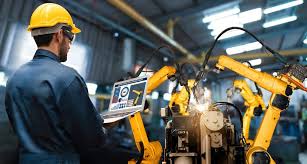Robotics is making waves across various industries worldwide, enhancing productivity, safety, and overall efficiency. As technological advancements in artificial intelligence (AI), machine learning, and automation continue, robots are becoming key players in transforming industries.
1. Robotics in Manufacturing and Production
In the manufacturing sector, robotics has significantly improved production lines by increasing speed, accuracy, and safety. Robots are now capable of performing repetitive tasks such as assembly, packaging, and quality control with precision, reducing human error and lowering production costs. This not only boosts efficiency but also allows workers to focus on more complex, value-added activities.
For example, in the automotive industry, robots have been instrumental in assembling cars with high precision and speed. This innovation has been essential in meeting high demand while maintaining the safety of workers.
2. Robotics in Healthcare
Robots have found a prominent place in healthcare, from surgical assistance to patient rehabilitation. Robotic surgical systems, such as the da Vinci Surgical System, allow surgeons to perform minimally invasive surgeries with great precision, leading to faster recovery times and fewer complications. In rehabilitation, robots can help patients regain mobility through automated physical therapy, aiding in quicker recovery from injuries or surgeries.
Additionally, robotic exoskeletons are being developed to assist individuals with mobility impairments, allowing them to walk again, providing hope for many who suffer from conditions like paralysis.
3. Robotics in Agriculture
Agriculture is also seeing a robotic revolution, with robots designed to harvest crops, plant seeds, and even monitor plant health. Automated tractors, drones, and harvesting robots improve efficiency in the fields while reducing the need for human labor, especially in labor-intensive activities like fruit picking. These technologies have the potential to help meet the increasing global demand for food in an environmentally sustainable manner.
4. The Future of Robotics in Industry
As robots become more intelligent, we are likely to see an increase in cobots (collaborative robots) that work alongside humans in a shared workspace. These robots can improve human productivity by handling dangerous or strenuous tasks while humans focus on more strategic or creative roles. Robotics will continue to disrupt industries, unlocking new efficiencies and creating a new era of automation.
Conclusion
Robotics is changing the face of industries across the globe. From manufacturing to healthcare and agriculture, robots are enhancing productivity and improving the quality of services provided. As technology advances, we can expect even more innovations that will further revolutionize how industries operate and improve the quality of human life.
